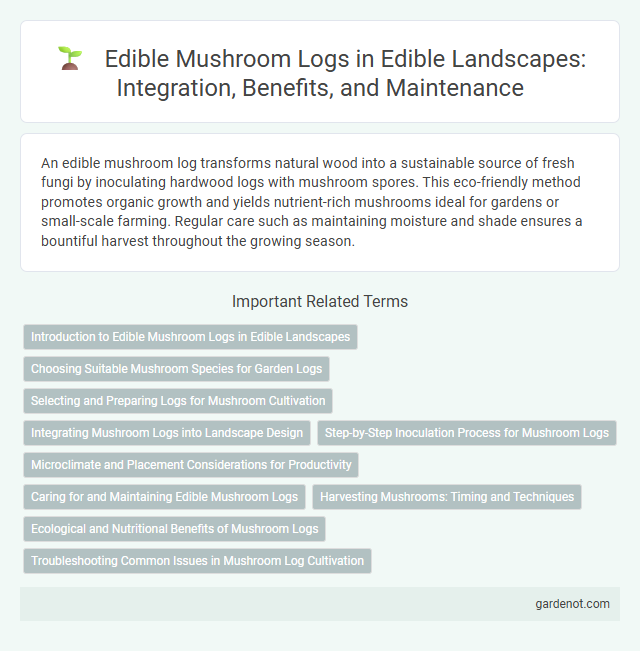An edible mushroom log transforms natural wood into a sustainable source of fresh fungi by inoculating hardwood logs with mushroom spores. This eco-friendly method promotes organic growth and yields nutrient-rich mushrooms ideal for gardens or small-scale farming. Regular care such as maintaining moisture and shade ensures a bountiful harvest throughout the growing season.
Introduction to Edible Mushroom Logs in Edible Landscapes
Edible mushroom logs provide a sustainable and productive element in edible landscapes by utilizing logs inoculated with mushroom spores to grow nutrient-rich fungi. These logs support species such as shiitake, oyster, and lion's mane mushrooms, enhancing ecosystem diversity and soil health. Incorporating edible mushroom logs into a landscape promotes local food production and offers a low-maintenance, high-yield harvest throughout the growing season.
Choosing Suitable Mushroom Species for Garden Logs
Selecting suitable mushroom species for garden logs involves prioritizing varieties that thrive on hardwood substrates, such as shiitake or oyster mushrooms, known for their high yield and disease resistance. Choosing species compatible with local climate conditions and log types ensures faster colonization and sustainable fruiting cycles. Incorporating native or well-adapted species minimizes ecological disruption while maximizing edible harvests from the landscape.
Selecting and Preparing Logs for Mushroom Cultivation
Selecting hardwood logs such as oak, maple, or beech with a diameter of 4 to 8 inches provides optimal conditions for edible mushroom cultivation. Freshly cut logs, preferably harvested within two weeks, retain moisture and natural nutrients essential for fungal colonization. Preparing the logs by drilling evenly spaced holes and inoculating them with mushroom spawn ensures effective mycelium growth and a successful harvest.
Integrating Mushroom Logs into Landscape Design
Integrating mushroom logs into landscape design enhances biodiversity and introduces sustainable food production within outdoor spaces. These logs create microhabitats that support beneficial fungi, improve soil health, and provide fresh, organic mushrooms for culinary use. Strategically placing mushroom logs near shade-tolerant plants or among native vegetation maximizes their growth and ecological impact.
Step-by-Step Inoculation Process for Mushroom Logs
Start by selecting hardwood logs, preferably oak or maple, cut during dormancy to ensure optimal mushroom growth. Drill evenly spaced holes around the log surface, insert mushroom spawn plugs or sawdust spawn, and seal the holes with food-grade wax to protect the inoculant. Maintain the logs in a shaded, humid environment with regular watering, allowing mycelium to colonize for 6 to 12 months before harvesting edible mushrooms.
Microclimate and Placement Considerations for Productivity
Edible mushroom logs require a stable microclimate with consistent humidity levels between 80-90% and temperatures ranging from 55degF to 75degF to optimize fungal growth and fruiting. Placement in shaded, well-ventilated areas minimizes temperature fluctuations and prevents direct sunlight, preserving moisture essential for mycelium development. Strategic positioning near natural windbreaks or under canopy cover enhances microclimate stability, boosting overall mushroom log productivity.
Caring for and Maintaining Edible Mushroom Logs
Caring for and maintaining edible mushroom logs requires maintaining consistent moisture levels by soaking the logs regularly, especially during dry periods, to promote optimal fungal growth. Positioning the logs in shaded, humid environments helps prevent drying out and supports healthy mycelium development for higher mushroom yields. Regularly inspecting for pests and diseases while cutting away any contaminated sections ensures the longevity and productivity of the edible mushroom logs.
Harvesting Mushrooms: Timing and Techniques
Harvesting mushrooms from an edible mushroom log requires careful timing to ensure peak ripeness and flavor, typically when caps fully open but before spore release. Using a sharp knife or twisting gently at the base helps prevent damage to the mycelium, promoting future flushes. Maintaining optimal moisture and avoiding harsh handling enhances mushroom quality and yield.
Ecological and Nutritional Benefits of Mushroom Logs
Mushroom logs promote ecological balance by recycling organic waste and enhancing soil health through mycelium networks that improve nutrient cycling. These logs provide a sustainable source of nutrient-rich mushrooms, containing essential vitamins, minerals, and antioxidants that boost immune function. Their cultivation reduces reliance on synthetic fertilizers and pesticides, supporting environmentally friendly food production practices.
Troubleshooting Common Issues in Mushroom Log Cultivation
Mushroom log cultivation commonly faces issues like contamination, insufficient humidity, and poor mycelium growth. Contamination by mold or bacteria can be mitigated by using sterilized logs and maintaining sterile handling conditions. Consistent moisture levels around 85-95% and shaded environments promote healthy mycelium development and higher mushroom yields.
Edible mushroom log Infographic

 gardenot.com
gardenot.com